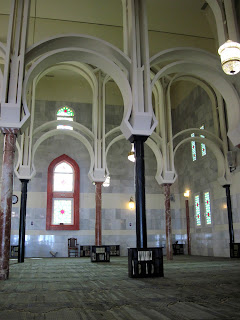Today I took advantage of one of the cultural events offered at SLU Madrid. They were taking a visit to Madrid's M-30 Mosque and Islamic Cultural Center. It's the largest operating mosque in Europe! I thought it would be good to learn a little bit about the history and practice Islam in Spain after the 1614 Morisco expulsions! And I really did learn a lot. I'm so glad I went.
So, they were meeting at 10:15. But I slept through my pleasant alarm, and didn't wake up until 9:50. Damn! I live a good 20-ish minute walk from campus and I wasn't even dressed. I'd never make it. I was bummed, and laid in bed being bummed about it for another ten minutes, resolving myself to having missed it, which was lame of me. At 10am it occurred to me that it's only a 5 minute drive via taxi, which would only cost me like 4 euros. The event was free anyway, so it would be worth it. If I leapt out of bed and could wash my face, brush my teeth, put on clothes and mascara, and grab a breakfast bar in the space of 10 minutes, I could totally make it. Plus everything here starts on "Spanish time," aka, late, so I knew I had at least a five minute cushion on top of that. So I rushed! And I made it! And I'm glad I did because it was a very cool morning excursion.
SLU Students headed toward the mosque
Madrid's Mosque
Trying to contain the blonde frizz
Me and Laura, a SLU undergrad I chatted with throughout morning, wearing our makeshift hijabs!
SLU girls donning scarves for our tour
I was most interested in hearing about the last two centuries, because I knew nothing at all about the recent history of Islam in Spain. She explained that there was a lot of religious freedom and toleration in the mid to late 1800s, (which made sense to me given the progressive freedoms of the Bohemian movements in Europe - think Moulin Rouge time!) and that this was a good time for Muslims to be in Spain. But under Franco, (a dictator who ruled Spain from 1936-1975) Roman Catholicism was the only legally permitted public religion in Spain. People could believe and practice their faiths in their homes, to an extent, but only the Catholic Church could advertise, own property, or have any public presence. It reminded me of a religious status not quite as bad as persecuted Moriscos practicing crypto-Islam, but not as good as the medieval dhimmi status. Things like civil marriage, divorce, and contraception were also outlawed in Spain, which was problematic for many Spanish families, whose previous civil marriages and/or divorces were no longer recognized by the state. It was only after the death of Franco in the 1970s that other religions could begin to have a public presence again in Spain.
In 1992, on the 500th anniversary of the 1492 expulsion of the Jews and many Muslims from Spain, this mosque was built, and since then, the presence of the Muslim population in Madrid has grown considerably.
After our tea and lesson in Islam, we went into the prayer space itself. First we had to remove our shoes, a possibility I'd not considered when throwing clothes on this morning, and at that moment I was very grateful I'd chosen to wear socks! I was surprised at how soft and thick the carpet was once we stepped onto it though! Must have been at least an inch of dense comfortable pile!
Barefoot SLU students settled on the comfy carpet in the mosque
The Qibla, the prayer nook positioned in the direction of Mecca
Our guide, explaining the religious features of the mosque, and our SLU organizer/translator on her right
Me at the Cathedral Mosque in Cordoba in 2010, and the simple, modern interpretation in Madrid
The way the laws stand today in Spain, mosques can be built, religious freedom of worship is guaranteed in the state, but it's not complete - certain restrictions still apply. For example, this mosque's minaret is purely architecturally decorative, as it is illegal to sound the call to prayer. Church bells ring hourly, but the muezzin is not permitted to call Muslims to Salat. (This word, which is the second pillar of Islam, is often translated as "prayer" but it really means something more like "connection with God" - prayer is what you do within that connection.) Because the muezzin's call is simply a reminder to pray, and has no religious significance in and of itself, it is not protected under any religious freedom laws, and can be banned under the laws regarding city noise.
Madrid's silent minaret
Our guide and translator explained that religion and politics are still fraught with tension in Spain, and although there has been significant progress in recent decades, it's still a very complicated situation. In addition to modern global fears of Islamic extremism and terrorism clouding people's judgement about mainstream Islam, here in Spain in particular there is also a fear that allowing further accommodations and freedoms to Muslims would be like inviting them to 'reconquer' Spain as they did in the Middle Ages. The ideology and glory of the Christian Reconquista still holds strong, and the Church and many Spanish people are hesitant to give up any ground on the matter.
All in all, I'm really glad I decided to hop in that taxi this morning so I wouldn't miss this visit. I had a wonderful time, learned more than I expected to, and have a much better understanding of the history of Christian and Muslim relations throughout the history of Spain.











No comments:
Post a Comment